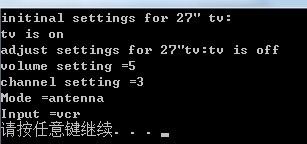【C++ Primer】第十五章 友元、异常和其他 --之一--->友元和嵌套类
一,友元
1)可以将类作为友元,友元类的所有方法都可以访问原始类的私有成员和保护成员。
2)下面例子介绍了 电视类和遥控器类,其中遥控器类为电视类的友元类
3)注意:友元关系不具对称性。即 A 是 B 的友元,但 B 不一定是 A 的友元。 友元关系不具传递性。即 B 是 A 的友元,C 是 B 的友元,但是 C 不一定是 A 的友元。
#include <iostream>
using namespace std;
class TV
{
private:
int state;// on or off
int volume; //assumed to be digitized
int maxchannel;// maximum number of channels
int channel;//current channel settings
int mode;//broadcast or cable
int input;//tv or vcr
public:
friend class Remote;//遥控器类
enum{off,on}; //枚举
enum{minval,maxval=20};
enum{antenna,cable};
enum{tv,vcr};
TV(int s=off,int mc=100):state(s),volume(5),maxchannel(mc),channel(2),mode(cable),input(tv){} //构造函数
void onoff(){
state=(state == on)?off:on;
}
bool ison()const{
return state == on;
}
bool volup();
bool voldown();
void chanup();
void chandown();
void set_mode(){
mode = (mode == antenna)?cable:antenna;
}
void set_input(){
input=(input == tv)?vcr:tv;
}
void settings()const;
} ;
class Remote//遥控器友元类
{
private:
int mode;
public:
Remote(int m=TV::tv):mode(m){} //遥控的是电视而不是 vcr
bool volup(TV &t){ //遥控器的操作都是来源于电视对自身的操作 ,所以友元遥控器的方法都是调用电视的成员函数
return t.volup();
}
bool voldown(TV &t){
return t.voldown();
}
void onoff(TV &t){
return t.onoff();
}
void chanup(TV &t){
return t.chanup();
}
void chandown(TV &t){
return t.chandown();
}
void set_chan(TV &t,int c){ //唯一需要作为友元的方法,因为它用来访问TV类的private成员
t.channel=c;
}
void set_mode(TV &t){
t.set_mode();
}
void et_input(TV &t){
t.set_input();
}
};
/*下面是电视的成员方法实现*/
bool TV::volup()
{
if(volume<maxval)
{
volume++;
return true;
}
else
return false;
}
bool TV::voldown()
{
if(volume>minval)
{
volume--;
return true;
}
else
return false;
}
void TV::chanup()
{
if(channel<maxchannel)
channel++;
else
channel=1;
}
void TV::chandown()
{
if(channel>1)
channel--;
else
channel=maxchannel;
}
void TV::settings()const
{
cout<<"tv is "<<(state == off?"on":"off")<<endl;
if(state == on)
{
cout<<"volume setting ="<<volume<<endl;
cout<<"channel setting ="<<channel<<endl;
cout<<"Mode ="<<(mode == antenna?"cable":"antenna")<<endl;
cout<<"Input ="<<(input == tv?"vcr":"tv")<<endl;
}
}
int main()
{
TV s27;
cout<<"initinal settings for 27\" tv:\n";
s27.settings();
s27.onoff();
s27.chanup();
cout<<"adjust settings for 27\"tv:";
s27.settings();
return 0;
}
输出为:
二,嵌套类
1)嵌套与包含的区别
包含意味着将类对象作为另一个类的成员
对类进行嵌套,不创建类成员,而是定义了一种类型,该类型仅在包含嵌套类的类中使用。struct (结构)实际上是一种嵌套类
2)嵌套类和访问权限
| 声明位置 | 包含它的类是否可以使用 | 从包含它的类派生出来的类,是否可以使用 | 外部世界是否可以使用 |
| 私有部分 | 是 | 否 | 否 |
| 保护部分 | 是 | 是 | 否 |
| 共有部分 | 是 | 是 | 是 |




 浙公网安备 33010602011771号
浙公网安备 33010602011771号